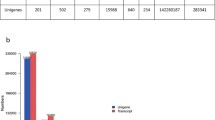Abstract
Limited emphasis has been given to the molecular study of apomixis, an asexual method of reproduction where seeds are produced without fertilization. Most buffelgrass (Pennisetum ciliare (L.) Link syn = Cenchrus ciliaris L.) genotypes reproduce by obligate apomixis (apospory); however, rare sexual plants have been recovered. A modified differential display procedure was used to compare gene expression in unpollinated ovaries containing ovules with either sexual or apomictic female gametophytes. The modification incorporated end-labeled poly(A)+ anchored primers as the only isotopic source, and was a reliable and consistent approach for detecting differentially displayed transcripts. Using 20 different decamers and two anchor primers, 2268 cDNA fragments between 200 and 600 bp were displayed. From these, eight reproducible differentially displayed cDNAs were identified and cloned. Based on northern analysis, one cDNA was detected in only the sexual ovaries, two cDNAs in only apomictic ovaries and one cDNA was present in both types of ovaries. Three fragments could not be detected and one fragment was detected in ovaries, stems, and leaves. Comparison of gene expression during sexual and apomictic development in buffelgrass represents a new model system and a strategy for investigating female reproductive development in the angiosperms.
Similar content being viewed by others
References
Altschul SF, Gish W, Miller W, Myers EW, Lipman DJ: Basic local alignment search tool. J Mol Biol 215: 403–410 (1990).
Asker SE, Jerling L: Apomixis in plants. CRC Press, Boca Raton, FL (1992).
Bashaw EC, Hanna WW: Apomictic reproduction. In: Chapman G (ed) Reproductive Versatility in the Grasses, pp. 100–130. Cambridge University Press, Cambridge, UK (1990).
Burson BL, Voigt PW, Sherman RA, Dewald CL: Apomixis and sexuality in eastern gamagrass. Crop Sci 30: 86–89 (1990).
Campbell SC, Craig WG, Scott EB: Apomixis and sexuality in three species of Amelanchier, shadbush (Rosaceae, Maloideae). Am J Bot 74: 321–328 (1978).
Chomczynski P, Sacchi N: Single-step method of RNA isolation by acid guanidium thiocyanate-phenol-chloroform extraction. Anal Biochem 161: 156–159 (1987).
Crane CF, Carman JG: Mechanisms of apomixis in Elymus rectisetus from eastern Australia and New Zealand. Am J Bot 74: 477–496 (1987).
Decrooq-Ferrant V, Van Went J, Bianchi MW, de Vries SC, Kreis M: Petunia hybrida homologues of shaggy/zeste-white 3 expressed in female and male reproductive organs. Plant J 7: 897–911 (1995).
Gustafsson Å: Apomixis in angiosperms II. Lunds Univ Årsskr N F II 43: 71–179 (1947).
Heck GR, Perry SE, Nichols KW, Fernandez DE: AGL 15, a MADS domain protein expressed in developing embryos. Plant Cell 7: 1271–1282 (1995).
Hussey MA, Bashaw EC, Hignight KW, Dahmer ML: Influence of photoperiod on the frequency of sexual embryo sacs in facultative apomictic buffelgrass. Euphytica 54: 141–145 (1991).
Knox RB: Apomixis: seasonal and population differences in a grass. Science 157: 325–326 (1967).
Koltunow AM: Apomixis: embryo sacs and embryos formed without meiosis and fertilization in ovules. Plant Cell 5: 1425–1437 (1993).
Liang P, Pardec AB: Differential display of eukaryotic messenger RNA by means of the polymerase chain reaction. Science 257: 967–971 (1992).
McClelland M, Mathieu-Daude F, Welsh J: RNA fingerprinting and differential display using arbitrarily primed PCR. Trends Genet 11: 242–246 (1995).
Nogler GA: Gametophytic apomixis. In: Johri BM (ed) Embryology of Angiosperms, pp. 475–518. Springer-Verlag, New York (1984).
Oh BJ, Balint DE, Giovannoni JJ: A modified procedure for PCR-based differential display and demonstration of use in plants for isolation of genes related to fruit ripening. Plant Mol Biol Rep 13: 70–81 (1995).
Sherwood RT, Young BA, Bashaw EC: Facultative apomixis in buffelgrass. Crop Sci 20: 375–379 (1980).
Sherwood RT, Berg CC, Young BA: Inheritance of apospory in buffelgrass. Crop Sci 34: 1490–1494 (1994).
Vielle J-Ph, Burson BL, Bashaw EC, Hussey MA: Early fertilization events in the sexual and aposporous egg apparatus of Pennisetum ciliare (L.) Link. Plant J 8: 309–316 (1995).
Young BA, Sherwood RT, Bashaw EC: Cleared pistil and thick sectioning techniques for detecting aposporous apomixis in grasses. Can J Bot 57: 1668–1672 (1979).
Author information
Authors and Affiliations
Rights and permissions
About this article
Cite this article
Vielle-Calzada, JP., Nuccio, M.L., Budiman, M.A. et al. Comparative gene expression in sexual and apomictic ovaries of Pennisetum ciliare (L.) Link.. Plant Mol Biol 32, 1085–1092 (1996). https://doi.org/10.1007/BF00041392
Received:
Accepted:
Issue Date:
DOI: https://doi.org/10.1007/BF00041392




